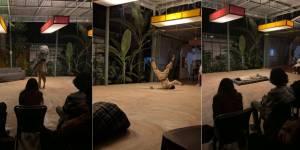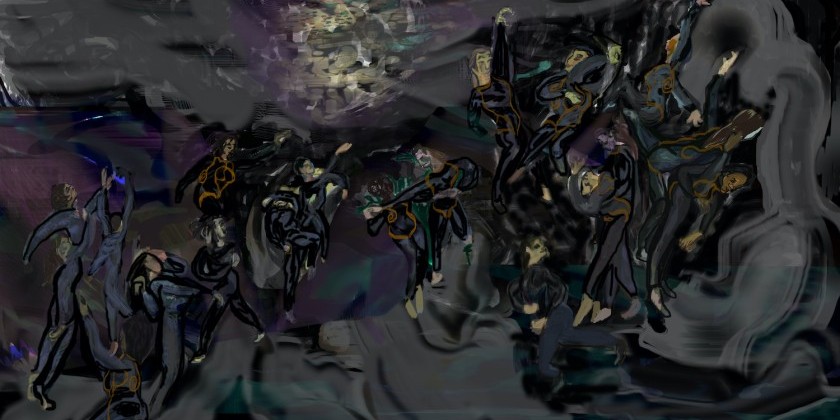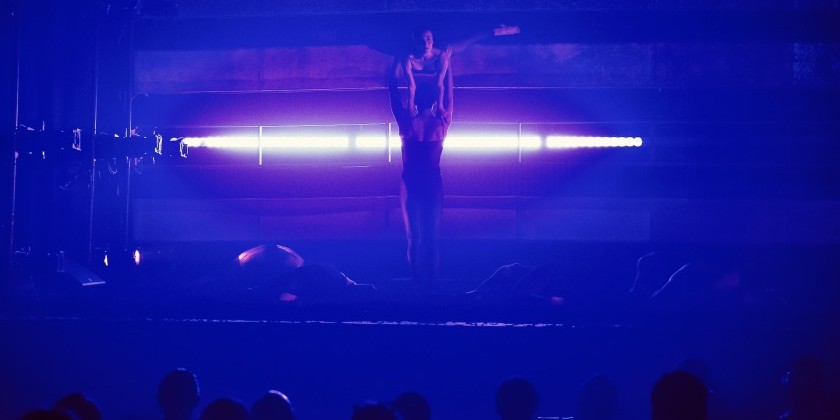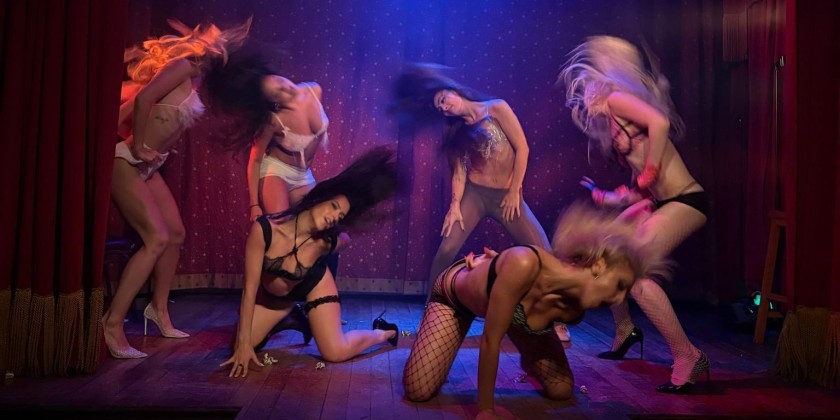AUDIENCE REVIEW: The Good, the Bad, and the Ghostly: "New Combinations" at NYCB
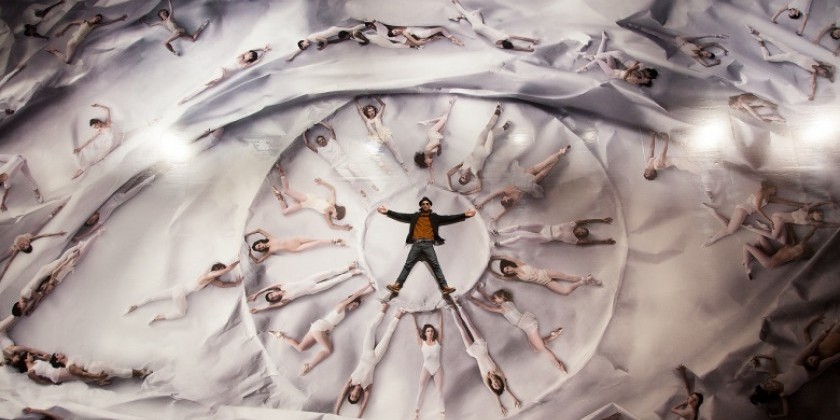
Company:
New York City Ballet
Performance Date:
January 31, 2014
Photographed by Lili Holzer-Glier
Freeform Review:
Performed January 31, 2014
David H. Koch Theatre, Lincoln Center
New York, NY
By Katherine Bergstrom
For many audience members, New York City Ballet will always be Mr. Balanchine’s company. Though NYCB still regularly rotates a good number of Balanchine works into its repertoire each season, current Artistic Director Peter Martins has also made commissioning and performing new works by an array of popular choreographers a priority, the result of which was clearly displayed on their “New Combinations” program last Friday, January 31st.
The program featured three works by three different choreographers: Mauro Bigonzetti’s "Vespro," which he created for NYCB in 2002, Angelin Preljocaj’s "Spectral Evidence," which premiered at NYCB’s 2013 Fall Gala, and finally, the centerpiece of the evening, the world premiere of Liam Scarlett’s "Acheron." Taking on the choreography of three separate minds is undeniably a stylistic challenge, made doubly hard by the fact that these dancers have all trained primarily for the performance of Balanchine ballets. But despite the stylistic incongruity, the dancers took the stage with a confidence befitting one of New York’s prize possessions.
Bigonzetti’sVespro, the first piece on the program, was unfortunately also the most tedious. Choreographed in 2002, Vespro was the first in a series of four works created by the Italian choreographer for NYCB. Set to an original score by one of Bigonzetti’s frequent collaborators, Bruno Moretti, the curtain opened to reveal a pianist, singer, and soprano saxophonist on stage, accompanied by principal dancer Andrew Veyette. Though Veyette’s dancing left nothing to be desired, the choreography did: the only really exciting moment came when Veyette ended a dance phrase by pounding the piano keys with his extended leg, and by the third time around, this etiquette breach was nothing special. Bigonzetti’s biggest problem seemed to spring from an overzealous approach to task of creating a contemporary ballet. The choreography fluctuated between gesture-heavy sequences (most of which felt cryptic and frivolous) and attempts to configure the body into “modernized” ballet shapes. Although it was clear Bigonzetti wanted to cater to the incredible balletic facility of his cast, the result was a ballet that looked contrived, not contemporary. Even Maria Kowroski and Ashley Bouder, who each gave wonderful performances in their featured sections, couldn’t save this piece from being forgettable.
Perhaps Vespro‘s lacking was made all the more apparent by the subsequent work, Angelin Preljocaj’s phenomenal "Spectral Evidence." Using a smattering of John Cage’s creepiest scores, Preljocaj’s piece for four couples drew the audience into a world that was at once innocent and ghastly. With the women dressed in flat ballet slippers and white nightgowns and the men in high-collar suits (thanks to costume designer Olivier Theyskens of Theory), Preljocaj likened his dancers to characters in a Gothic novels. And just as the authors of these tales revealed the darker, supernatural side of their characters, so too does Preljocaj show that beauty does not equate to innocence – when the women turn around, they reveal that the backs of their costumes are cut away and replaced with deep red patches resembling the red muscles groups one might see drawn on a skeleton in an anatomy book. The image suggests that these dancers have a grisly (or perhaps “spectral” is the word to use here) side that couldn’t quite be masqueraded, and indeed, they serve as Preljocaj’s ghostly (and at times demonic) figures. While a Cage sound score of animalistic swallowing, breathing, and sniffing noises plays, the four couples each dance a tensepas de deuxin which it’s unclear which partner is going to be the other’s victim. A surprisingly theatrical solo for Robert Fairchild set to Cage’s Aria No. 2was another unsettling yet impressive point, as he embodied Cage’s myriad different vocal characters in rapid fire through a series of jumps and turns.
Simple yet versatile set pieces – four hollow ramps that were rotated or placed on end to create different scenes throughout the piece – added to the devilish mood. At one point the ramps are laid on their side so the dancers can pound their fists in rhythm, as if possessed. Later on, the ramps are turned on end and the women step inside, only to be devoured by projected flames, each in their own personal Hell. As troubling as these images sound, they are not unfamiliar; instead, they evoke Bertha Mason burning down Thornfield Hall, or Lucy Westerna rising from her tomb to terrorize Seward and Dr. Van Helsing. It’s no secret that artistic culture is fascinated by the unreal, and by combining 19th-century visual imagery with 20th-century music and 21st-century technology, Preljocaj uses the vehicle of concert dance to his advantage to present an entrancing, and frankly frightening, mlange of these provocative stimuli in real time.
Although Preljocaj’s piece stole the spotlight, the “New Combinations” program was built around the world premiere of Scarlett’sAcheron, the Royal Ballet wunderkind’s first piece for NYCB. Having received considerable praise for his recent works at Miami City Ballet (Viscerain 2012 andEuphoticin 2013), Scarlett, The Royal Ballet’s first Artist in Residence and only 27 years old, is on track to become a big name in ballet. WithAcheron, he clearly used the talent at NYCB to his advantage, playing to the fearless strength of both Ashley Bouder and Sara Mearns and their partners Adrian Danchig-Waring and Amar Ramasar. In keeping with the theme of featured male soloists on this program, Scarlett’s piece featured a recurring solo for Anthony Huxley. Huxley has a knack for fluidity that I’d yet to see from him in other works; hopefully this featured role from Scarlett will put him on Peter Martins’ radar for next season’s casting.
In real life, Acheron is the name of a river in Northwestern Greece, but in classical Greek mythology, Acheron was the underworld’s river of woe, and in Dante’sInferno,the Acheron constitutes the boundary into Hades. Scarlett’sAcheronis not nearly as morbid as it’s name suggests, but with Francis Poulenc’sConcerto in G for Organ, Strings, and Timpaniproviding the accompaniment, it is certainly dramatic. The piece begins with the entire cast onstage, but soon one dancer is the only one moving amongst this sea of bodies. As the dancing speeds up, Bouder and Mearns, as well as Huxley, each have moments of jetting through the waves of fellow dancers, and a recurringpas de deuxbetween Rebecca Krohn and Tyler Angle sees Krohn as somewhat of a lost soul traipsing through the deluge. Krohn has yet to develop the consistency and on-stage personality that make Bouder and Mearns so wonderful, but asone of the newest additions to the female principal roster, she is still finding her edge.
The fluid imagery is complimented by Scarlett’s costumes, knee-length flowing dresses which he designed himself with help from NYCB’s costume director Marc Happel (although poor Ms. Krohn’s performance was clearly affected by the large hole that appeared on the side seam of her bodice almost immediately). Unlike Bigonzetti and Preljocaj, Scarlett opted for a clear stage, with the hope that lighting choices would provide the suggestion of setting. More importantly, the clear stage meant more room for dancing.
Commissioning new work is always accompanied by some degree of risk, but the stars of New York City Ballet have yet again proved that they are perhaps the world’s most versatile group, far more than just preservers of the Balanchine style. “New Combinations” will be performed throughout NYCB's Winter 2014 Season, on Feb. 5, Feb. 8 (matinee) and Feb. 11.
While you’re at the Koch Theatre, be sure to check out NYCB’s latest installment to it’s Art Series, featuring the work of French artist JR. The work, which is composed of images of NYCB dancers, covers the entire floor of the second level promenade, and looks particularly impressive when seen from the 4th ring. JR’s work will be on view throughout the winter season.
This review can also be read on my blog Point of Contact at http://ptofcontact.wordpress.com/




